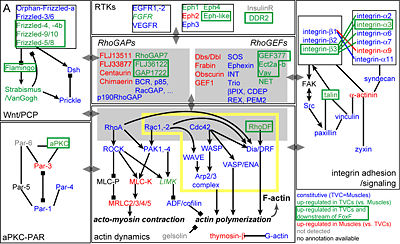Christiaen:Research: Difference between revisions
No edit summary |
|||
| Line 14: | Line 14: | ||
[[image:Research_Fig2.jpg|thumb|400 px|left|'''Fig.2. Regulated effector genes and cellular processes'''.]]The aforementioned ''view from the network'' approach will be complemented by a reciprocal focus on the sub-cellular processes at work during TVC migration and subjected to transcription regulation. We will pay particular attention to the transcriptional control of the Leader-trailer polarity and basic processes underlying protrusive activity, such as adhesion and actin dynamics (Fig. 2). We will address these questions using specific molecular tools and quantitative imaging methods.<br><br><br><br><br><br><br><br> | [[image:Research_Fig2.jpg|thumb|400 px|left|'''Fig.2. Regulated effector genes and cellular processes'''.]]The aforementioned ''view from the network'' approach will be complemented by a reciprocal focus on the sub-cellular processes at work during TVC migration and subjected to transcription regulation. We will pay particular attention to the transcriptional control of the Leader-trailer polarity and basic processes underlying protrusive activity, such as adhesion and actin dynamics (Fig. 2). We will address these questions using specific molecular tools and quantitative imaging methods.<br><br><br><br><br><br><br><br> | ||
==surrounding tissues and extrinsic factors influencing TVC migration== | ==surrounding tissues and extrinsic factors influencing TVC migration== | ||
[[image:Research_Fig3.jpg|thumb|250px|right|'''Fig.3. Surrounding tissues influence TVC migration.''']]Transcription profiles of migrating TVC determine their ability to interpret the extracellular signals that influence their behavior. Therefore, the biological relevance of specific intrinsic properties can only be fully appreciated in light of the developmental context in which TVC migrate. These extrinsic cues will be sought by a candidate gene approach, relying on previously obtained whole genome microarray data, and unbiased screens to assess the function of surrounding tissues during TVC migration.<br><br><br><br><br><br><br><br><br><br> | [[image:Research_Fig3.jpg|thumb|250px|right|'''Fig.3. Surrounding tissues influence TVC migration.''']]Transcription profiles of migrating TVC determine their ability to interpret the extracellular signals that influence their behavior. Therefore, the biological relevance of specific intrinsic properties can only be fully appreciated in light of the developmental context in which TVC migrate. These extrinsic cues will be sought by a candidate gene approach, relying on previously obtained whole genome microarray data, and unbiased screens to assess the function of surrounding tissues during TVC migration.<br><br><br><br><br><br><br><br><br><br><br> | ||
==cellular modules and the diversity of developmental cell behavior== | ==cellular modules and the diversity of developmental cell behavior== | ||
Finally, we postulated that complex cell behaviors result from the tissue-specific association of ''cellular modules'', which is directly controlled by the GRN. This theoretical possibility will be explored by studying the deployment of candidate cellular modules in other tissues and by analyzing other migratory behaviors in the ascidian embryo and possibly other species. These projects will rely most intensively on collaborations.<br> | Finally, we postulated that complex cell behaviors result from the tissue-specific association of ''cellular modules'', which is directly controlled by the GRN. This theoretical possibility will be explored by studying the deployment of candidate cellular modules in other tissues and by analyzing other migratory behaviors in the ascidian embryo and possibly other species. These projects will rely most intensively on collaborations.<br> | ||
Revision as of 12:15, 12 July 2009
page in construction
background information

In ascidians, the so-called trunk ventral cells (TVCs) migrate from the anterior part of the tail to the ventral part of the trunk in tailbud embryos and constitute the precardiac mesoderm. They originate from a single pair of blastomeres in the early embryo, called B7.5 cells (Fig.1A). The B7.5 blastomeres give birth to the TVCs and their sister cells, the anterior tail muscles (ATMs), which differentiate into skeletal muscle and do not migrate (Fig.1B). Previous studies showed that TVC-specific gene expression and migration require transcriptional inputs from the bHLH transcription factor Mesp, the FGF signaling pathway and the forkhead transcription factor FoxF (Fig.1C). Because of these functional evidences, TVC migration constitutes a suitable model system to investigate the relationship between transcription regulation and directed cell migration.
To this aim, I developed a method utilizing fluorescence activated cell sorting (FACS) and microarray analysis to obtain TVC-specific genome transcription profiles. These data, together with an analysis of the function and regulation of the Rho GTPase RhoDF, indicated that 1) the gene regulatory network impinges on most cellular processes underlying cell migration, including actin dynamics, cell-matrix adhesion, polarity and vesicle trafficking; 2) for each cellular process, only a subset of the effector genes are subjected to transcription regulation and 3) specific cell behaviors result from the modular association of individual cellular processes that can be experimentally uncoupled from each others. This study led to the identification of additional candidate regulators and effectors of TVC migration and to the definition of a conceptual and experimental framework for future studies.
transcription regulators controlling TVC migration
A systems-level analysis is required to understand the structure and function of the interface between the precardiac GRN and TVC migration. Towards this goal, functional analysis of additional candidate transcription factors and signaling molecules will be conducted. Special attention will be devoted to the forkhead transcription factor FoxF and its downstream candidate transcription regulators. These projects will employ tissue-specific interference with transcription regulators function, knock-down by microinjection of morpholinos oligonucleotides and selected experimental manipulations will be subjected to subsequent analysis using FACS and whole genome microarrays.
intrinsic cellular processes underlying TVC migration

surrounding tissues and extrinsic factors influencing TVC migration

cellular modules and the diversity of developmental cell behavior
Finally, we postulated that complex cell behaviors result from the tissue-specific association of cellular modules, which is directly controlled by the GRN. This theoretical possibility will be explored by studying the deployment of candidate cellular modules in other tissues and by analyzing other migratory behaviors in the ascidian embryo and possibly other species. These projects will rely most intensively on collaborations.
